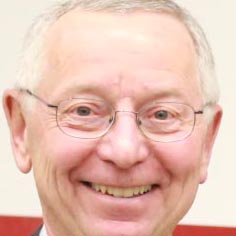LA Times journalist shares insights from decades of covering SCOTUS
Not only did Los Angeles Times Supreme Court reporter David Savage make some significant SCOTUS predictions when he recently appeared at USC Gould, he also revealed what it’s really like to cover the justices who serve on the highest court in the land.
“It’s a great beat because the Court takes on such serious issues,” Savage said, noting that the Court has held his interest for nearly 30 years because it’s different every Term. “The longer I cover the Court, the less I want to leave.”
Savage gives the justices “a lot of credit for drama,” as they usually wait until the very last day of their nine-month term in June to announce their opinions. “SCOTUS starts slow and builds, usually saving their rulings on the biggest cases until the very last day. Often, we have no idea until then how they are going to rule,” he said.
This was Savage’s second time as a guest at the bi-annual “Conversations With the Dean” event hosted by USC Gould School of Law Dean Robert K. Rasmussen. The speaker series features high-profile business leaders, politicians and attorneys, including USC Gould alumni. A crowd of approximately 150 students, faculty and staff gathered to hear the discussion with Savage.
Although he never attended law school, Savage jokingly said he knows enough law to fake it. In his nearly 30 years of covering the court - and witnessing the swearing in of every single sitting justice – Savage has been privy to a rare view of SCOTUS in action. He is one of about a dozen reporters nationwide whose beat is the Supreme Court. Savage predicted the Court will rule against the Obama administration and limit the tax subsidies under the Affordable Care Act. The aftermath is “going to be messy,” he noted. Same-sex marriage, however, will be upheld, according to Savage, in another tight 5-4 decision, with Justice Anthony Kennedy casting the key vote.
Given that the Supreme Court hears 75 cases a term (down from 150 when Savage first started), the veteran reporter has witnessed countless arguments, which led Dean Rasmussen to ask what Savage thinks makes for an “effective appellate advocate”? “Poor lawyers spend a lot of time citing precedent,” Savage answered. “But the justices are swayed by a legal argument that makes sense. Lawyers need to explain their arguments in simple, straightforward language.” He ranked Paul Clement (who’s appeared nearly 70 times before the U.S. Supreme Court) and Ted Olson (who argued landmark cases Bush v. Gore and Perry v. Schwarzenegger) as among the best attorneys he has witnessed. Savage also noted that before John Roberts became the current Supreme Court Chief Justice, he was also a “strong advocate” in the Court.
A student asked Savage: “How much do oral arguments matter?” Savage reported that Justices Roberts and Kennedy have acknowledged, “that oral arguments can cause them to think about a case differently. But 95 percent of time, the way justices go in thinking about case is how they are thinking when they go out.”
Savage also addressed speculation that Justice Ruth Bader Ginsburg, who recently turned 82, should soon retire. “She’s sharp and well-prepared. She enjoys the work and has no inclination to leave,” said Savage, who noted that many justices serve decades-long terms. “Justice John Paul Stevens quit when he was 90 and I asked him: ‘Why did you quit? You’re only 90!”
According to Savage, Justice Antonin Scalia brings some life to the courtroom coverage. “I’m grateful that Scalia is on the court because he’s not boring,” Savage said. “If you need one quote to sum up a case, I go right for his name in the transcript. He’s a wonderful person to cover.”
-By Anne Bergman

















